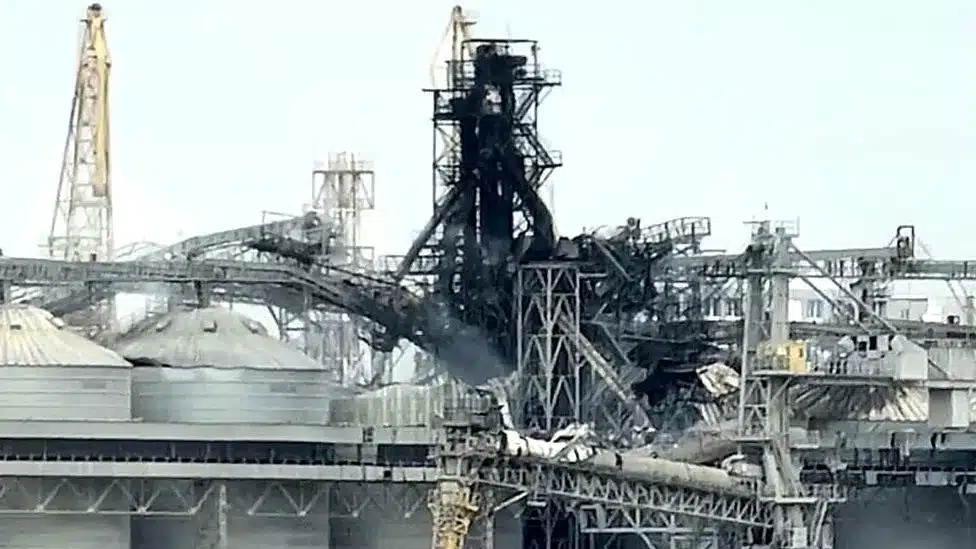Officials report that 60,000 tonnes of grain have been destroyed, and storage infrastructure has been damaged following Russian missile attacks on Ukraine’s Black Sea coast.
Ukraine’s Agriculture Minister, Mykola Solskyi, stated that a significant portion of export infrastructure is now out of operation.
Russia’s withdrawal from an international grain deal, which ensured safe passage for exports across the Black Sea, has contributed to the escalation of the situation.
The Kremlin claimed that its export demands were not being met, leading to its decision to withdraw from the agreement.
Shortly after the withdrawal, Russia launched missile strikes on the southern port cities of Odesa and Mykolaiv, causing significant damage.
Subsequent attacks targeted grain terminals and port infrastructure in Odesa and Chornomorsk, extending further along the Black Sea coast.
The impact of these attacks poses a serious threat to Ukraine’s grain exports and agricultural sector.
Odesa military spokesman Serhiy Bratchuk called it a “truly massive attack”. The agriculture minister said the 60,000 tonnes destroyed in the strike were “supposed to be loaded on a large-tonnage ship and sent through the grain corridor 60 days ago”.
Ukrainian President Volodymyr Zelensky said each missile strike was a blow not just to Ukraine, but to “everyone in the world striving for a normal and safe life”.
France and Germany also condemned the attack. Germany Foreign Minister Annalena Baerbock said that by covering Odesa with a hail of bombs, Russian President Vladimir Putin was robbing the world of any hope of Ukrainian grain and “hitting the world’s poorest”.
The infrastructure ministry published a series of photos showing damage to silos and other grain facilities. Officials said there had been damage to wharves and reservoirs, but it was international Ukrainian traders and carriers that had suffered the most.
Russian war commentators said the damage proved that Kyiv was unable to shoot down the majority of Russian missiles and drones.
Officials said the co-ordinated attack involved Kalibr cruise missiles, Onyx supersonic and Kh-22 anti-ship missiles as well as kamikaze drones, fired from the Black Sea, Crimea and southern Russia. Although 37 Russian missiles and drones were shot down, a number did penetrate Ukrainian defences, they said.

“I saw a red flash in the window and reacted immediately,” one resident told the Reuters news agency.
“I went downstairs, it was noisy and filled with smoke outside, people were in panic, some were crying, glass shards were scattered all over. It was impossible to remain in the area.”
Russia referred to its initial attack on Odesa as a “retaliatory strike” in response to an alleged attack on the Russian-built bridge over the Kerch Strait, which connects occupied Crimea to Russia. The bridge was targeted by seaborne drones, resulting in the destruction of a section and the death of a Russian couple.
On Wednesday, further disruptions occurred in Crimea as a fire triggered explosions at an ammunition depot near a military training range. As a precautionary measure, approximately 2,200 residents from four nearby villages were evacuated.
Russian-appointed officials also closed a 12-km section of the Tavrida motorway, which connects Simferopol and Sevastopol in southern Crimea to the Kerch Strait bridge. The construction of this road began in 2017 under Russia’s occupation authorities.
Multiple explosions were heard in the area starting at around 04:30 on Wednesday. The cause of the fire near the city of Staryi Krim is under investigation, although unconfirmed reports on social media suggested Ukrainian involvement in the incident.
The Kremlin confirmed that President Putin had been briefed on the situation. Sergei Aksyonov, the Russian-appointed leader in Crimea, stated that the cause of the fire at the military range was being investigated and that no injuries were reported.

